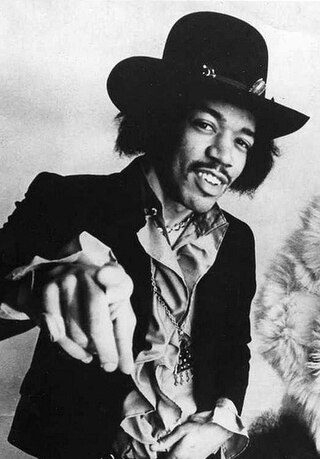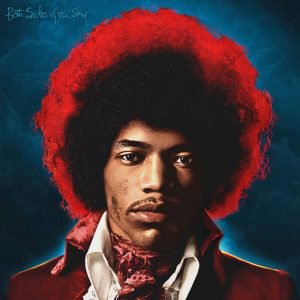Related Research Articles

Electric Ladyland is the third and final studio album by the Jimi Hendrix Experience, released in October 1968. A double album, it was the only record from the Experience with production solely credited to Hendrix. The band's most commercially successful release and its only number one album, it was released by Reprise Records in the United States on October 16, 1968, and by Track Records in the UK nine days later. By mid-November, it had reached number 1 on the Billboard Top LPs chart, spending two weeks there. In the UK it peaked at number 6, where it spent 12 weeks on the British charts.

Edwin H. Kramer is a South African-born recording producer and engineer. He has collaborated with several artists now in the Rock and Roll Hall of Fame, including Jimi Hendrix, the Beatles, David Bowie, the Rolling Stones, Led Zeppelin, Eric Clapton, the Kinks, Kiss, John Mellencamp, and Carlos Santana, as well as records for other well-known artists in various genres.
Roland Robinson was a longtime Memphis studio session bass player and songwriter. Robinson was a cousin and close friend of Teenie Hodges, Al Green's lead guitarist in the 1970s when Green recorded with the famed Hi Records staff band, the Hi Rhythm Section.

Band of Gypsys is a live album by Jimi Hendrix and the first without his original group, the Jimi Hendrix Experience. It was recorded on January 1, 1970, at the Fillmore East in New York City with Billy Cox on bass and Buddy Miles on drums, frequently referred to as the Band of Gypsys. The album mixes funk and rhythm and blues elements with hard rock and jamming, an approach which later became the basis of funk rock. It contains previously unreleased songs and was the last full-length Hendrix album released before his death.
The Electric Flag was an American soul rock band, led by guitarist Mike Bloomfield, keyboardist Barry Goldberg and drummer Buddy Miles, and featuring other musicians such as vocalist Nick Gravenites and bassist Harvey Brooks. Bloomfield formed the Electric Flag in 1967, following his stint with the Butterfield Blues Band. The band reached its peak with the 1968 release, A Long Time Comin', a fusion of rock, jazz, and R&B styles that charted well in the Billboard Pop Albums chart. Their initial recording was a soundtrack for The Trip, a movie about an LSD experience by Peter Fonda, written by Jack Nicholson and directed by Roger Corman.

George Allen "Buddy" Miles Jr. was an American composer, drummer, guitarist, vocalist and producer. He was a founding member of the Electric Flag (1967), a member of Jimi Hendrix's Band of Gypsys (1969–1970), founder and leader of the Buddy Miles Express and later, the Buddy Miles Band. Miles also played and recorded with Carlos Santana and others. Additionally, he sang lead vocals on the critically and commercially acclaimed California Raisins claymation TV commercials and recorded two California Raisins R&B albums.
Blues is a compilation album of blues songs recorded by American singer/songwriter/musician Jimi Hendrix. Compiled by interim Hendrix producer Alan Douglas, it was released April 26, 1994, by MCA Records. The album contains eleven songs recorded by Hendrix between 1966 and 1970, six of which were previously unreleased. Hendrix wrote seven of the pieces; other writers include Muddy Waters, Booker T. Jones, and Elmore James. Most are demos, jams, and live recordings, which Hendrix may or may not have completed for release.

James William McCarty is an American blues rock guitarist from Detroit, Michigan. He has performed with Mitch Ryder and The Detroit Wheels, the Buddy Miles Express, Cactus, The Rockets, the Detroit Blues Band, and more recently, Mystery Train. Since about 2014 Jim McCarty has joined forces with Detroit blues guitarist/songwriter Kenny Parker in The Kenny Parker Band along with several other veteran Detroit blues/rock musicians. He also makes guest appearances with other Detroit bands, most notably for an annual pre New Year's Eve party at one of his favorite clubs, "Callahan's", with The Millionaires, a nine piece jump blues band.

Hendrix in the West is a live album by Jimi Hendrix, released posthumously in January 1972 by Polydor Records (UK), and in February by Reprise Records (US). The album tracks are split between those recorded in 1969 by the Jimi Hendrix Experience with bassist Noel Redding and drummer Mitch Mitchell and in 1970 with Billy Cox and Mitchell during The Cry of Love Tour.

Jimi Hendrix (1942–1970) was an American guitarist whose career spanned from 1962 to 1970. His discography includes the recordings released during his lifetime. Prior to his rise to fame, he recorded 24 singles as a backing guitarist with American R&B artists, such as the Isley Brothers and Little Richard. Beginning in late 1966, he recorded three best-selling studio albums and 13 singles with the Jimi Hendrix Experience. An Experience compilation album and half of a live album recorded at the Monterey Pop Festival were also issued prior to his death. After the breakup of the Experience in mid-1969, songs from his live performances were included on the Woodstock: Music from the Original Soundtrack and More and Band of Gypsys albums. A studio single with the Band of Gypsys was also released.

Crash Landing is a posthumous compilation album by American guitarist Jimi Hendrix. It was released in March and August 1975 in the US and the UK respectively. It was the first Hendrix album to be produced by Alan Douglas.

Nine to the Universe is a posthumous compilation album by American guitarist Jimi Hendrix. It was released in March 1980 in the US and in June 1980 in the UK. It was the third album of Hendrix recordings to be produced by Alan Douglas.

Rainbow Bridge is a compilation album by American rock musician Jimi Hendrix. It was the second posthumous album release by his official record company and is mostly composed of recordings Hendrix made in 1969 and 1970 after the breakup of the Jimi Hendrix Experience. Despite the cover photo and subtitle Original Motion Picture Sound Track, it does not contain any songs recorded during his concert appearance for the 1971 film Rainbow Bridge.

People, Hell and Angels is a posthumous compilation album by the American rock musician Jimi Hendrix. The fourth release under the Experience Hendrix deal with Legacy Recordings, it contains twelve previously unreleased recordings of tracks he was working on for the planned follow-up to Electric Ladyland. It was released on March 5, 2013.
Ed Chalpin was a record executive and producer. He is probably remembered for his association with Curtis Knight and the Squires which caused problems for Jimi Hendrix throughout his career. Chalpin is responsible for the recordings from that period, some of which appear on You Can't Use My Name: The RSVP/PPX Sessions.
Herbie Rich was an American multi-instrumentalist from Omaha, Nebraska, who was a member of The New Breed, The Electric Flag, and the Buddy Miles Express. He also played with Jimi Hendrix, Mike Bloomfield and others.

An American Music Band was the second album by the band the Electric Flag, released in 1968. Band founding member Mike Bloomfield had earlier left the group and did not perform on this release.

Both Sides of the Sky is a compilation album by Jimi Hendrix, released by Legacy Recordings and Experience Hendrix on March 9, 2018. The 13-track album, including ten previously unreleased recordings, were recorded with either the Jimi Hendrix Experience or the Band of Gypsys lineups, and features guest appearances from Stephen Stills, Johnny Winter and Lonnie Youngblood.
Booger Bear is an album released by The Buddy Miles Express in 1973. It was released in both stereo and quadraphonic formats. It made the Billboard charts in 1974.
TaharQa Z. Aleem and Tunde Ra Aleem were formerly known as Albert and Arthur Allen. Although they wore many hats, they are most notable for being American musicians, producers, authors, and entrepreneurs originally based out of Harlem, NY, in addition to being close friends and musical collaborators with Jimi Hendrix.
References
- ↑ Encyclopedia of Classic Rock, By David Luhrssen, Michael Larson – Page 234 Miles, Buddy (1946–2008)
- ↑ Billboard , October 12, 1968 – Page 12 Talent, Signings
- ↑ Jim McCarty – Cactus website
- ↑ Billboard, November 16, 1968 – Page 14 Talent, Quicksilver Fast and Furious, Express Rolls
- 1 2 Billboard, November 30, 1968 – Page 77, 78
- ↑ Scuse Me While I Kiss the Sky: Jimi Hendrix: Voodoo Child, By David Henderson – Page 251
- ↑ Billboard, May 24, 1969 – Page 57 Audio Retailing, 'Church' in Merc. Six-LP Package
- ↑ Billboard, June 7, 1969 – Page 57 Top LPs
- ↑ Billboard, September 6, 1969 – Page 8 5 Suits Charging Pact Violations Are Filed
- ↑ The Guinness Who's Who of Seventies Music, Colin Larkin – Page 70 Cactus
- ↑ The 100 Greatest Bands of All Time: A Guide to the Legends Who Rocked the World, edited by David V. Moskowitz – Page 352 The Jimi Hendrix Experience (1966–1970)
- ↑ Echoes: The Complete History of Pink Floyd, By Glenn Povey – > May 1972, Sunday 21 May CONCERT
- ↑ Billboard, November 24, 1973 – Billboard's Top Album Picks, Pop
- ↑ Billboard, February 16, 1974 – Page 50 Billboard's Top Album Picks
- ↑ Billboard, December 15, 1973 – Page 21 Billboard Soul LPs
- ↑ Billboard, January 5, 1985 – Page 3 Ethiopia-Aid Single, Video Take Off – by Paul Grein
- ↑ Angel Air Is 10: 1997–2007, compiled by James McCarraher – Page 206
- ↑ Jazz Times , 05/01/2004 – Buddy Miles Express: Hell and Back by Bill Milkowski
- ↑ Discogs – Buddy Miles Express – Expressway To Your Skull
- ↑ Discogs – Buddy Miles Express – Electric Church
- ↑ Discogs – Buddy Miles Express – Booger Bear
- ↑ Discogs – Buddy Miles Express – Hell And Back
- ↑ Discogs – Buddy Miles Express Discography , Singles & EPs
- ↑ 45Cat – Buddy Miles Express – Discography
- ↑ Discogs – Buddy Miles Express Discography, Albums
- ↑ AllMusic – Buddy Miles Express, Hell and Back, Releases
- ↑ Find A Grave – Herbert Lewis Rich
- ↑ Nebraska Music Hall of Fame website – HERBIE RICH Archived 2021-09-22 at the Wayback Machine
- ↑ The Independent , Friday 29 February 2008 – News › Obituaries Buddy Miles: Flamboyant Hendrix drummer
- ↑ Legacy.com – Virgil Gonsalves, Jr., Obituary